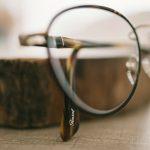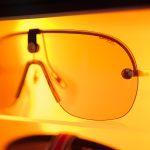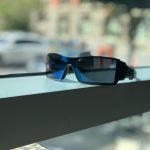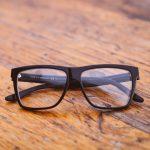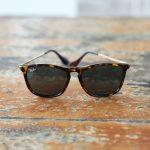Eyeglass Frame Size Chart: How do I know my glasses frame size?
All glasses frames have information about various frame measurements printed on them. These measurements are usually found on the inside of the arms, but they may also be printed on the back of the bridge or the inside of the nose piece of your glasses. This makes it really easy. We produced a helpful glass frame size guide to make the procedure quick and straightforward. You need to know the measurements when looking for eyeglass and sunglass frames.
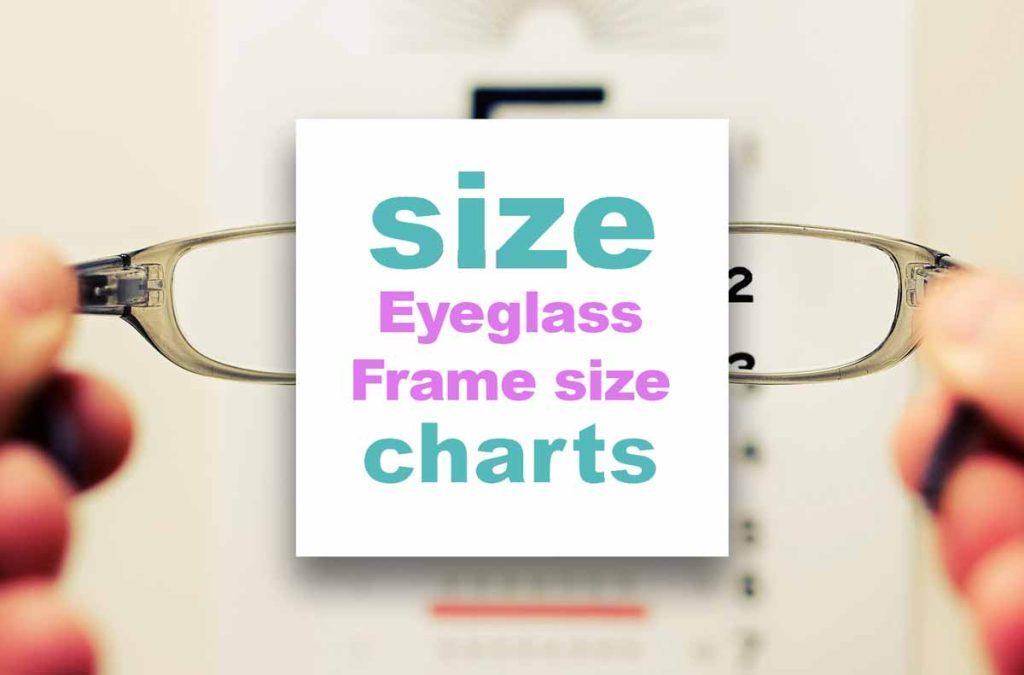
Good glasses should properly distribute pressure over the nose, head breadth, and ears. They should also, of course, complement your facial type. So, how do you pick the frame size for your glasses? When picking your pair of frames, use an eyeglass frame size chart to assist you in determining the correct frame size. Brands like Rayban, Gucci, … have great models with frames that fit each type of face.
Table of content:
Looking for sunglasses sizes, check the article here
Quick Summary: How do I know my frame size for glasses?
The size of the frame is indicated by the three digits inscribed on the inside of your spectacles. These numbers are often located inside one of the temples of your glasses, which keeps them tucked behind your ears.
The numbers for the eyeglass frame sizes are as follows:
- The dimensions of the eyes
- The bridge’s dimensions
- The Temple length
- The width of the frame
- The height of the lens
Millimeters are used for all frame measurements (mm). Let’s now examine each in more detail.
Eyeglass Frame Size Chart: Where to Find the Frame Measurements
Finding the correct frame size is critical when purchasing eyeglasses. But did you know it’s also relatively easy? We have prepared all you need to know about eyeglass and sunglasses frame dimensions.
You can easily measure your face with the help of a ruler/tape measure and a mirror. Simply place the ruler right on one of your head’s temples. Then measure the distance from one temple to the other.
Check out this illustration;
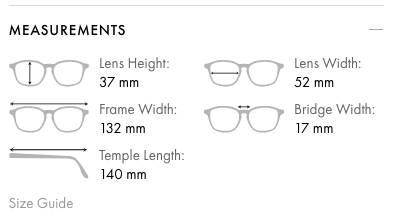
You can then use the measurements you get to approximate the correct size of your eyeglass frame by using the eyeglass frame size chart below. Please note that each manufacturer will always have a custom size chart for their glasses.
Face size conversion into eyeglass frame size
| Face Size – Temple to Temple (mm) | Eyeglass Frame Size (mm) | Size Range | |
| INCHES | mm | ||
| 115-129 | 1.6-1.9 | 40-49 | Small |
| 130-134 | 1.9-2.0 | 49-54 | Medium |
| 135-139 | 2.2-2.3 | 55-58 | Large |
| 140-144 | 2.3 and above | 58 and above | Extra Large |
Take a peek at our sizing guide, compared with hat size, to see where you might measure up.
Eyeglass frame size with hat size chart
How to take your hat size and all about hat size charts, read here
| Head Measurement | 21 1/4 | 21 5/8 | 22 | 22 3/8 | 22 3/4 | 22 1/2 | 23 7/8 | 24 1/4 | 24 5/8 | 25 |
| Hat size | 6 3/4 | 6 7/8 | 7 | 7 1/4 | 7 3/8 | 7 1/2 | 7 5/8 | 7 3/4 | 7 7/8 | 8 |
| Sunglasses size | SMALL FIT | STANDARD FIT | LARGE FIT |
NOTE: Comparing hat size is only meant to provide a general frame of reference for eyeglass fit
Children’s hat sizes you can find here, Boys Growth Chart – A Useful Size Guide For boys Shoes And Clothing
Getting to know your frame size
Again, it’s always important to determine which size frames are appropriate for you to guarantee that your pair of eyeglasses fit flawlessly. The best place to begin is with the dimensions of your current pair of glasses. You may see some numerals on the arms or the bridge. The frame model, color code, and dimensions are frequently included in these statistics. All glasses’ frames include information regarding various frame dimensions printed on them. These measurements are typically printed on the inside of the arms, but they may also be placed on the rear of the bridge or the inside of the nosepiece of your spectacles.
The initial numbers we need to find will always be in a three-digit series, such as 53-20-140. These numerals can be represented as ‘a-b-c’ to make them easier to remember. A tiny rectangular shape may be present between the digits ‘a’ and ‘b,’ making them simpler to distinguish. The lens diameter is the number on the left side of the rectangle, or ‘a’ in the sequence. The lens’s width is at its widest point, measured in mm.
The bridge width is the number on the right side of the sequence’s rectangle or ‘b’. The bridge width is critical for a properly fitting pair of glasses. Finally, ‘c’ is the length of your glasses’ arms. For a similar feel and fit, match measures ‘a’ and ‘b’ to your new spectacles.
Eyeglass Frame size and dimensions
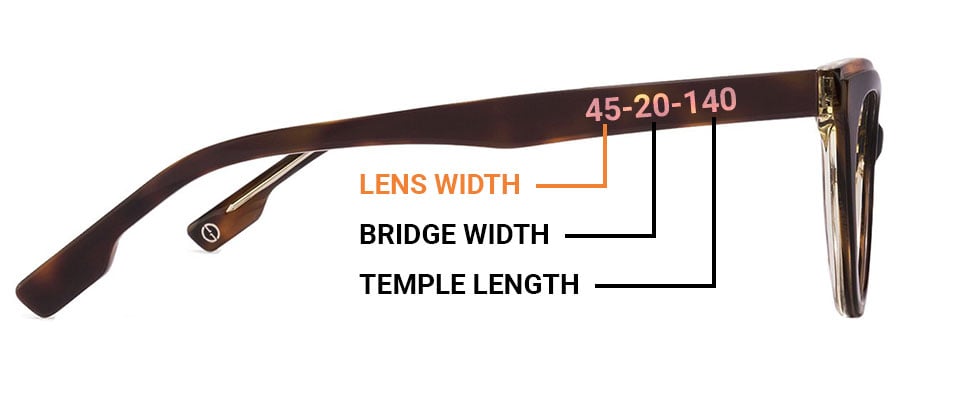
Image source: https://www.lenskart.com/frame-size-guide
The three digits printed on the inside of your eyeglasses show the size of the frame. You typically find these numerals inside one of the temples of your spectacles, which keep them in place behind your ears.
The following are the glasses frame size numbers:
- The eye size
- The bridge size
- The temple length
- The frame width
- The lens height
All frame measurements are in millimeters (mm). Let’s now take a close look at each.
Eye size
The horizontal length of the lenses determines the eye size. Most frames will have an eye size ranging from 44 to 62 mm. The focal length is the vertical distance between the sides of a rectangle containing the lens form (in mm).
On your existing glasses, you may find the lens width and bridge width measurements on the inside of the frame (printed on the arms or the bridge). The size of your lenses is a personal choice, but it’s also influenced by the style of your frame and your prescription. Remember to measure from the inside of the frame while taking measurements.
Bridge size
This is the distance between the lenses. Most eyeglass sized frame will have a bridge size of 14 to 24 mm. If you have a thin bridge or close-set eyes, this number should be lower (15mm to 18mm), but if you have a more prominent bridge or wide-set eyes, a more significant number should be used (18mm to 22mm).
In other words, it’s the distance between the nasal surfaces of the rims on a plastic or metal frame or the distance between the nasal surfaces of the lenses in rimless frames. If a frame features adjustable nose pads on metal arms, you can make various adjustments to ensure a comfortable fit.
Distance between pads
You can adjust the distance between the pads depending on the circumstances, as follows;
Increasing the distance
In the following situations, increasing the distance between the pads may be appropriate:
- The frame size is too large for the face.
- A progressive (Varifocal) lens’ bifocal segments or distance section are excessively high.
- The bridge is far too narrow for the nose.
- The distance between the eye and the lens is excessive.
Reducing the distance
In the following situations, reducing the distance between the pads may be appropriate:
- The frame protrudes too far from the face.
- A progressive (Varifocal) lens’ bifocal segments or distance portion are too low.
- The lenses are too near to the lashes and eyes.
- The bridge of the nose is too low.
When choosing the correct bridge width, the bridge should fit comfortably on your nose. This value should be lower if you have close-set eyes or desire a thin bridge. This value should be more significant if you have wide-set eyes or desire a broad bridge.
Your nose’s position might help you decide which frame type is ideal for you. If your nose is on the upper side of your face, an eyeglass design with a bridge that is even with the brow line of the frame will appear most acceptable. A-frame with a lower bridge and curved brow line will better fit your features if your nose is a little lower on your face.
Temple length
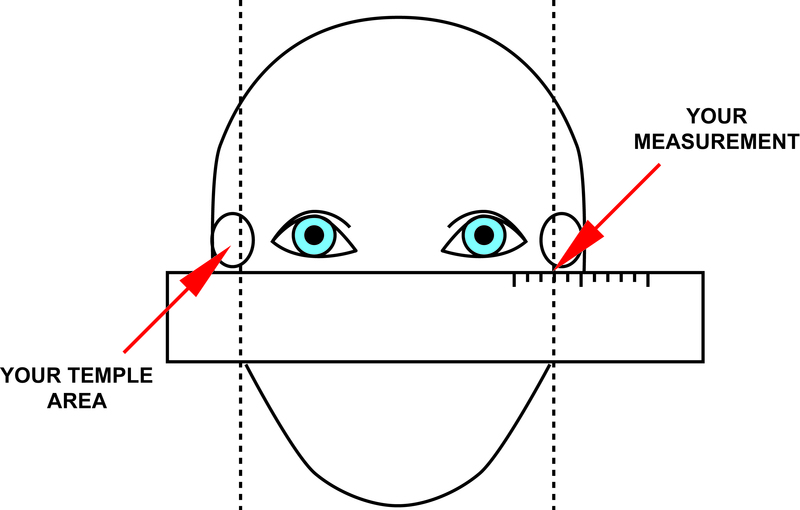
Image source: https://www.easyoptic.cz/eye-wear/eyeglass-size-chart/
The temple length refers to the length of the frame’s arms. The length of the temple, including the bend, is measured from the screw position to the end of the temple. Temple lengths range from 120mm to 150mm, with the most frequent being 135mm, 140mm, 145mm, and 150mm. The length of the temples is often underestimated, yet it is crucial. If the temple is too short, it will not bend correctly behind the ears to protect the frames from slipping down and moving around. The end of the temple should extend halfway down the back of the ear when bent.
If your temples are too short, look at alternate frames. Temple lengths vary across brands, so look for ones between 145 and 150mm. Look for acetate temples that can be adjusted for the optimum fit, but ensure the length is long enough for the temples to sit horizontally rather than angling up over the ear. The temple should fit perfectly outside your ear and horizontally along your face. Measure one temple from screw to tip to determine its length.
Frame width
| Frame Size | Eyeglasses | Sunglasses |
| Small | Below 48 mm | Below 55mm |
| Medium | 48 mm- 55 mm | 56 mm- 64 mm |
| Large | Above 55 mm | Above 64 mm |
Another dimension is the overall width of the frames. It’s crucial to understand that this is determined by the thickness of the rims and how far the lugs are swept out from the frame. Measure from one end of the screw to the other end of the screw. It offers you an idea of how wide a frame is overall. When it comes to obtaining a pair of glasses that fit well and showcase the individual’s particular characteristics, the frame width is typically the most crucial consideration. Your eyes should be almost centered in the breadth of the lenses as a general rule. When it comes to picking frames, the form of your face is the most significant consideration.
A narrow frame will make your face appear large, and a wide frame will make your face appear narrower. It is one of the vital factors in obtaining a good pair of glasses. Choose a slightly broader frame than your face – no more than a finger width between the temple and the bridge of your nose. Your frames are too broad if they are any wider.
Your glasses’ temples do not have this measurement written on them. To identify it, lay your measuring tape horizontally over the front of your frames, taking into account any hinges or design features that protrude to the sides.
The lens height
This is the vertical distance of your eyeglass lenses within the frame at their widest point. When measuring bifocals or progressive lenses, the lens height is crucial.
How to measure yourself to determine your Eyeglass frame size
Perhaps you’re thinking of buying your eyeglasses online but aren’t sure how to measure yourself for a perfect pair of glasses correctly. All you need is a ruler, then proceed as follows;
- Hold the ruler in line with your temples in front of a mirror.
- In inches, measure the distance between your temples.
Calculate the overall frame width of the glasses you desire now that you’ve measured your face. It is the total width of both the lenses and the bridge. The size of your frame may vary by 3mm from your measurement. Select a frame size that corresponds to your face’s length.
Measuring your Eyeglass size explained
Picking Eyeglasses According to Face Type
Choosing the appropriate pair of new glasses may be a challenging task, made much more difficult by a large number of types available nowadays. How do you know which style to buy and if it will look well on your face?
The first step in choosing the right frame is to understand your face shape, and with this guide, you’ll be a frame shape expert in no time!
What’s your face shape?
Did you know that a person replaces their glasses every three years on average? When it’s time to acquire new glasses, be sure they’re in the proper shape! Understanding which ones are perfect for you may really assist bring out your distinct face characteristics with so many options. Many consumers only replace their eyeglasses every few years due to the estimated cost in many sales outlets. Most consumers want to get the most use out of each pair of glasses they purchase. Many frame manufacturers may occasionally surpass $1,000, so most users try to get the most out of each pair of glasses they buy. It also means that choosing a frame that is a touch out of your comfort zone may be a costly affair.
The common categories of face shapes include square, round, heart, triangular, and oval. It’s easy to figure out your facial shape, and there are two methods. The recommended way is to look in the mirror and trace your facial form with either lipstick or an erasable pen. The other option is to take a picture of yourself and then trace the form of your face with tracing paper.
Now that you know what sort of face shape you have, you can look through our specific recommendations to discover which style would suit you best.
Square shape face
The features on these type of faces are prominent and angular, with a sharp, straight line going from the brow to the jaw. Round and slimmer frames slightly broader on the side will seem harmonious and natural on square faces.
You’ll want frames that are proportional to the length and width of your face. The sharp angles of a square-shaped face will be softened by round and oval-shaped frames. On diamond-shaped faces, they’re also flattering.
Using colorful frames to attract attention away from the square form is a unique technique to make a square face appear appealing.
Round shape face
Round faces feature soft curves and smooth lines, with a face that is about the same width from the jaw to the brow. The cheeks are often prominent in round faces, and the chin is rounded with few angles. Unlike other facial shapes, a round face stands out since it is all about curves.
The most crucial aspect to remember when choosing glasses for round faces is to select frames that maximize angles. They look amazing with bold, angular glasses with clean lines.
Heart shape face
Heart-shaped features are largest at the brow and narrow down to the chin with high cheekbones. This facial shape, extended or round, offers the possessor a charming and cheery appearance.
It is commonly regarded as the most adaptable of all the facial forms. To balance and enhance their facial characteristics, they look terrific in winged-out frames that push out slightly broader than their forehead and rounded bases.
Triangular shape face
The bottom of a triangular face is the widest, while the top is the smallest. So you’re looking for a frame that’s the polar opposite of a mirror: bold on top, light on the bottom. Triangular faces will benefit from a combination of round and angular designs.
Look for the broadest styles at the top (wider frame) and smallest at the bottom, such as cat-eye sunglasses or D-frame shapes, to balance out your features.
Oval shape face
People with oval features look good in a variety of frame styles. Oval is the most ubiquitous face shape, with a smaller forehead and somewhat narrower chin, so have fun with the newest trends since they will work for you.
However, it does not imply that you may choose any frame off the rack. A-frame should accentuate your face’s strong qualities while downplaying its flaws, thus resulting in a flawlessly balanced appearance. It implies enhancing the face’s inherent balance and adding angles to its delicate contours for an oval face.
Look for a frame with the same width as the broadest section of your face, the area around your eyes. Square, rectangular frames, and geometric shapes are the most appropriate eyeglasses frames for oval features.
Conclusion on eyeglass frame size charts
The thing about eyeglasses is that most of us love them. Whether they are a pair of prescription glasses (prescription eyeglasses), multifocal lenses, single vision lenses for vision correction, cylindrical lenses, double lenses, rectangular lenses, bifocal contact lenses, angled glasses, or just for fun, you want to get the very best in terms of style and frame size.
Take your time and we’ll certainly be sure that you will be able to locate a pair of glasses that seem harmonic enough to add a natural balance to your face now that you know how to find the perfect glasses. Be sure to compare actual features on actual glasses, such as the range of vision and the overall basics of a frame that we have covered quite extensively.
Picture in this post by Clem Onojeghuo on Unsplash
Related Glasses and Goggles size charts
- Gucci Sunglasses Size and Fitting Guide Small – Regular – Large
- Persol Sunglasses Size and Fitting Guide for Men and Women
- Prada Sunglasses Size and Fitting Guide
- Carrera Sunglasses Size and Fitting Guide for Men & Women
- Oakley Sunglasses Size and Fitting Guide: Kids, Small to XL size
- Sunglasses Size for Kids and Adults, with Frame – Lens – Bridge Sizes
- Eyeglass Frame Size Chart: How do I know my glasses frame size?
- Ray-Ban Aviator Size Guide
- Wayfarer Sunglasses Size Chart


